

| NEC ULTRALITE & VERSA HISTORY |
 A Brief History of NEC - NEC, Originally called Nippon Electric Company Limited and rebranded to "NEC" in 1983. While they are a Multi-National technology company, they are more or less, from what I've been told, seen as the "IBM of Japan" by some people. They are based in Minato, Tokyo, Japan, and have had a longtime presense in Japan in computing starting with the PC-6800 and PC-8000 series in the early 1980's. By 1990, NEC Was the 4th largest computer company in the world.
A Brief History of NEC - NEC, Originally called Nippon Electric Company Limited and rebranded to "NEC" in 1983. While they are a Multi-National technology company, they are more or less, from what I've been told, seen as the "IBM of Japan" by some people. They are based in Minato, Tokyo, Japan, and have had a longtime presense in Japan in computing starting with the PC-6800 and PC-8000 series in the early 1980's. By 1990, NEC Was the 4th largest computer company in the world.
PREFACE: THE NEC ULTRALITE (1988-1993) 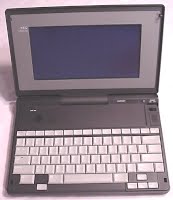 The original NEC Ultralite was a 4LB, NEC V30 (8086) based laptop computer released in 1988. It was the result of NEC's analog phone system division developing a compact terminal for PBX operators and techs while out in the field. At one point, someone from the PC division saw this device and asked if they could make it run DOS, the result was what we see to the left - the original NEC UltraLite, models PC-17-01 and PC-17-02.
The original NEC Ultralite was a 4LB, NEC V30 (8086) based laptop computer released in 1988. It was the result of NEC's analog phone system division developing a compact terminal for PBX operators and techs while out in the field. At one point, someone from the PC division saw this device and asked if they could make it run DOS, the result was what we see to the left - the original NEC UltraLite, models PC-17-01 and PC-17-02.
In 1990 the series continued with the NEC Ultralite 286P and 286V. The 286P was a CGA-based, monochrome laptop computer carrying the same light weight and superb battery life of the time, while the 286V was a color DSTN VGA solution running on the same 286 processor. By 1991-1992ish, the Ultralite Series had added some 386 SL and 386 SX models into the fold, including the SX/20, SL/20, SL/25C Color Active Matrix model, and the SL/25P which was the first pen/touch enabled unit they made right at the heels of the first attempt by the PC industry to make touch screens and stylus a normal input method. I have read reports of one 486 SL 33MHz model laround this time, but I have yet to see one turn up. This was largely the 386 Ultralite series.THE NEC ULTRALITE VERSA AND VERSAPAD (1993-1994) 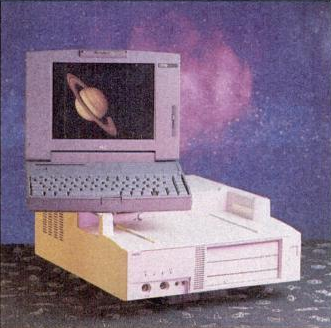 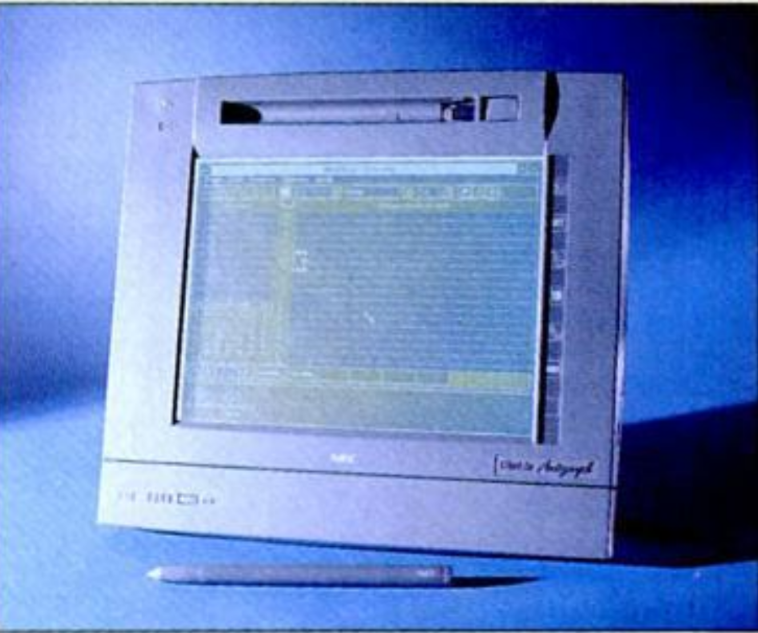 It seems NEC's motivations for the original NEC Versa was to create a sleeker laptop computer and attempt to somewhat consolidate their Pen Tablet - then known as the NEC UltraLite Autographer - and the NEC UltraLite Laptop, into a single model - the NEC UltraLite Versa - an "Ultra-Light-Versitile" device that could function as a tablet, laptop, and a desktop.
It seems NEC's motivations for the original NEC Versa was to create a sleeker laptop computer and attempt to somewhat consolidate their Pen Tablet - then known as the NEC UltraLite Autographer - and the NEC UltraLite Laptop, into a single model - the NEC UltraLite Versa - an "Ultra-Light-Versitile" device that could function as a tablet, laptop, and a desktop.
That said, UltraLite was a bit of a misnomer for this series because these laptops weigh about 7-8LBS fully loaded with drives and batteries - about the normal weight range for a early 1990's 486-class laptop computer. They are not that slim, the original UltraLite and Ultralite SX/SL have these beat in "slim" profile. About the only "UltraLite" features of the original line that were applied to the model was the long battery runtime, said to be about 8 Hours with Power Managemnet masterfully handled on a monochrome, low memory UltraLite Versa doing light to medium work. They were definatley Ultra, but sure not light. However, they would make your wallet lighter still at around $3000 for the average basic unit. The laptop boasted a few things. First off, a tool-less, user upgradable screen, memory, and hard disk. This was unheard of in the 1990's and sure as heck is now. This is where the "Versa" came from. For starters...need more RAM? You just had to purchase a sealed memory card from your computer shop, then slide off a cover under the right of the screen, and slip the card in or swap it out with the higher capacity one. Ditto the hard drive. Got an 80MB Drive, 80MB not enough? You could get a 120MB or 256MB Hard Disk and install it in a "VersaPak" caddy by sliding off the memory cover and one over cover. It was like a laptop with a "Mobile Rack" built into it. But the "Party Trick" as Beige-O-Vision calls it in his video, or the real star of the show, was the LCD Panel. The LCD Panel was detachable for two, actually three reasons. The first reason was you could flip it backwards for presentations. However, I question this and see of it as kind of dubious. If you really needed someone else to see the screen, then how would YOU see the screen to navigate a PowerPoint Presentation? What this sales point really was just a placeholder for the up and coming pen/touch system for the computer, which allowed you to flip the screen backwards, and latch it backwards, turning your computer into a pen/touch tablet - just like the Microsoft Surface, Lenovo Yoga, Dell XPS 13, HP Revolve, Samsung Flick, and many others would do 20 years later after Windows 8 came out. Sorry y'all, NEC was one of the FIRST to the convertible laptop/tablet game, 30 years before Windows 8.0. The biggest benefit of this not mentioned enough though, was that you could literally buy a base-level Versa and slowly upgrade it as needed over time. So say, you could spend about $2500 on a Versa 20, in mono, with one battery, no touch, 80MB HDD, 4MB of RAM (no card) - you could later toss in another 4MB RAM card, then throw on a color screen later on for about $500 more, then another hard disk later when you needed more space. There was this whole idea that you could gradually upgrade and spend less and "Get more". Ah, classic marketing. That said, the new UltraLite Versa was a darling of the computer magazines when it came out for it had the fastest graphic performance of anything out there at the moment except maybe one or two high-model IBM ThinkPads. The HDD speed was not the best. Also, this first outing was not without it's issues. For starters, i486 laptops started ot offer pointing devices by this point, usually trackballs or a trackpoint, but the UltraLite Versa required you get a "package" with the NEC/Microsoft BallPoint PS/2 Mouse that clipped to the side of the keyboard. The second biggest complaint was power supply size.
Not long after the UltraLite Versa was released, NEC was contracted by National Cash Register (NCR) to make their high end model laptop in their product line (that consisted mostly of laptops from other manufacturers including Samsung). The AT&T version of the NEC UltraLite Versa (33) was the 33MHz NCR Safari 3180. These NCR/AT&T branded laptops differed from a regular Versa by their color scheme. The screen and keyboard bezel were a brightere gray color, and the buttons, switches, and secondary characters on the keyboard were all a light "surf green" color. Also, color and black & white models could be told apart by the three gray or red/green/blue squares shown on the sticker on the LCD.
By the time of the Versa M-series, the Versa series had fallen a little bit. Some comptuer magazines were mentioning readers saying the power-consumption/runtime claims on battery were a bit over-exaggerated, and that they were quite overpriced being as one could buy a NanTan or even lower-end ThinkPad for less money. Also around this time, NEC released a special version of the M/75 and M/100 known as the "TC" models - "True Color" capable laptops capable of 16.8 million colors thusly photorealistic graphics. At the same time, the M/75 andn M/100 HC - for "High Resolution Color" (800x600) were ALSO released. This submodel carried over to the next as the most common configuration - the NEC Versa P/75.
GOING RETRO - AFTER THE HEYDAY, MY EXPERIENCES Many of these NEC Versa devices managed to retain much value and steady use up into and during the early 2000's as back then, laptop computers were still more expensive than an equivalent desktop, and people - myself included - were still using Windows 3.1 well into the first decade of the 21st century due to how expensive hardware was at the time. I remember looking on e-bay back in 2003 for my first laptop and running into Versa V/50s and M/75s left and right, but they were all getting rather high asking prices from $50 all the way up to $175 - and mind you, this is pre-x86 nostalgia here, when these things were considered "dinosaurs", "doorstops", and "boat anchors". 1gen Versas were only just slightly cheaper than an equivalent IBM ThinkPad - only slightly. I always liked them because they looked like a very legitimate early 1990's laptop. Skip ahead about 10 more years, now it's 2019, and I'm looking for a cheap, 486 laptop computer for retro-gaming and doing various oldschool internet stuff over WiFi with that was not just another $8 Pentium II that looks like someone's dog chewed it up and then pissed on it, and would fight me on DOS drivers every step of the way. I took a look at e-bay for an IBM ThinkPad or Compaq, and was HORRIFIED. The prices were god awful. $137.00 for a 755CD where the rubber turned to goo and the case was cracking!?!? Heck, I was finding carcasses of 486 thinkpads for over $200 + $56 shipping! It's bloody stupid. Compaq SLT 486 is $350.99. Oh look, here's one for $59.99, oh wait, that'ssomeone's bid. Oh look, there's a Toshiba for $40 - look it up, no sound card, DSTN, has a known issue with battery leakage - oh jebus. Dug around for NanTans but could not find enough on those (hence me picking them up and documenting them recently). AT&T Safari 3151s were basically a rare version of the Globalyst 200, which I was only finding DSTN models of.



Unfortunatley, the 3rd hand market for decent 486 laptops has been made utterly overpriced artificially by the growth of Retro-Computing on vintage IBM compatibles as a legitimate Hobby, with some examples reaching $200 or more now as of 2023. In 2019, this was really hitting it's stride and it was IMPOSSIBLE to find any of these for under $100, or even $200 as the case was with IBM ThinkPads due to percieved "better quality" vs. a comparable NEC, NanTan, or other branded product that's lesser known. At the time, the idea of negotiating a better price was not nearly as widespread as it is now. So I remembered a VCFED post around 2007 where a guy told me NCR made the laptops for AT&T and NEC, and as I had an AT&T Safari 3151 a long time back that I really loved and wished I still had, I decided to take a look at NEC.
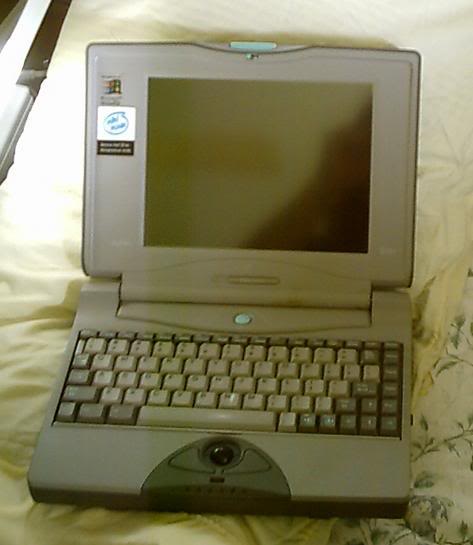

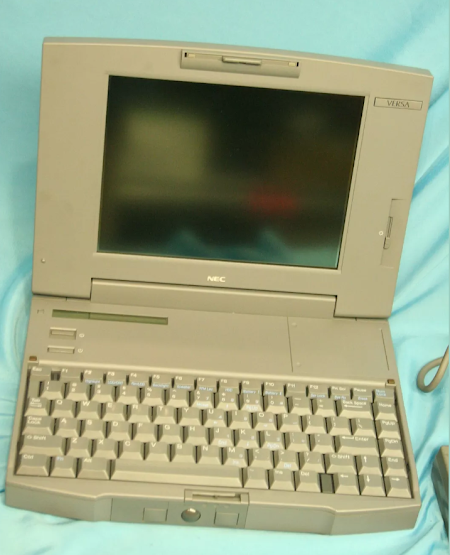
Here's a pictorial of what I was looking for. The AT&T Safari 3151 I used to have 2003-2005 on the left was said to be made by NCR who made laptops for NEC. This was incorrect. Turns out, NCR was bought out by AT&T in 1993, and both Samsung and NEC made laptops for AT&T/NCR after the aquisition. The laptop in the picture is a re-branded Samsung Notemaster 486P DX2-50 system. The middle is the presumably dead Safari 3180 I almost bought in the middle, good thing I didn't because it was a monochrome model, and likely suffered from the common capacitor issues that plague it and the NEC UltraLite Versa that it's based on (Versa 33). The far right is the laptop I bought - a 1994 NEC Versa 40EC PC-440-1531 used by a former Ford Motor Company engineer. Unfortunatley this laptop was destroyed in an accident in 2021 and is no longer here in one piece - though I MAY have enough parts to put another one together including some parts from this one. NEC Versas and the associated AT&T/NCR branded stuff was a heck of a lot cheaper. The reasons were numerous. First and foremost, I hate to point fingers, but 8-bit Guy, being one of the more popular YouTubers, made a video around that time about the best DOS gaming laptop - and his suggestions included IBM ThinkPads (which were already expensive), but his suggestions for the Compaq LTE and Toshiba Sattelite and Tecra models caused prices on those to shoot up massively. However, it made an EXCELLENT primer to bring me back up to speed on how to identify a laptop with a Active Matrix color screen. So for $35 I bought the Versa 40EC up top - which is gone now as I already said. Unfortunatley, though I admit there was some experimentation to see how my publication would change the market for these, my research and documentation spanning at least 2-3 websites I've made since then, has lead to a rise in the price of the 1st Generation Versa laptops. In that time, I've owned several units, both for parts, and working. These included: 1994 NEC Versa 40EC, 1994 NEC Versa M/75CP (touch screen!!), which I technically still have ala Frankenstein (lol, the "FrankenVersa"). An NEC Versa P/75HC I also still have that's a cantankerous mess periodically due to failing plastic, an NEC Versa V/50 that cost me only $15 and I had the parts to pimp it out, a UltraLite Versa 25C that was destroyed in shipping and used for parts, a Versa M/75TC that had a bad screen module, and a few other Versa 40ECs I used for parts, including a collection of those parts I have right now to BUILD an NEC Versa from parts. From my experience with this line, being a retro DOS gamer - the earliest units have a serious design flaw in that they used a lot of pin-through-hole capacitors that leak and smell like a bowl full of mussels. These units most often won't start up and need a recap to run at the very least. And they are a royal pain in the ass to do so because the power-controller is not socketed like it is on the E-series and later. The also lack the trackball. The best of the two parts-availability wise and hardiness wise are the Versa V and Versa E series, because they sold a ton of these. The Versa E series seems like it was a very popular product line used by major corporations at the time, much like many do Dell today. They also perform extremely well, punching well above their "weight class" for retro DOS gaming, making them somewhat on the slower end of a lower-end and not-as-well optimized DX4 system in performance. But they still have no sound and suffer from the brittle plastic issues that plague the Ultralite versions. The Versa M-series is my personal favorite. IF someone can get a good PCMCIA Sound Card going that's easily available for a decent price, these could be the ultimate MS-DOS retrogaming laptop computer. They already have the WSS compatible audio codec chip (Crystal CS4231KQ) that sounds incredibly good (16 bit 44.1KHz CD quality audio by default), but lacks FM Synthesis. The build structure is sturdy enough that even when plastic cracks to pieces, it still holds together. Mine even has a completley loose triangular piece of plastic holding the PCMCIA door on still - totally loose - and the door still stays on. The trackballs on these are flawless, and the keyboard is one of the best next to IBM. I have one with a 3M MicroTouch Touch Screen on it! Which makes the hinges and screen assembly far more hardy and sturdy than the typical Versa. The Versa P/75 is also a great little laptop, though the majority have been sold with the High Resolution Color 800x600 LCD panel, a lot of them in the smaller 9.4" variety, which end up letterboxed when running DOS games or anything that maxes out at 640x480p or less. But a Versa P/75 with a 640x480 color TFT is a force to be reckoned with - it has the ESS688 w/ OPL3 Yamaha FM Synth on-board, and thusly, will run almost any DOS game happily with perfect graphics and sound. The major drawback though, is that the increased cooling needs paired with some cost reduction measures has caused some structural integrity issues when combined with the brittle Brominated plastics NEC Used for these. There may come a time where I might look at doing some Resin-Cast Versa cases if possible to remediate these issues. Also, if you're expecting amazing whizz-bang Pentium performance from this computer, you might as well pass it by because it's basiically a Bus Castrated Pentium - or a 486 with Pentium instructions added really by the performance nature. There's a very slight uptick in performance, but nothing that makes it impressively faster than a similiarly equipped Versa M/75. It still has the same PCMCIA Type II card slots, same Cirrus Logic controller chip, same C&T 65545 1MB SVGA Graphics chipset, and the same glue logic for the most part as a regular, 486-based, NEC Versa M/75. I can see why PC Mag was a bit underwhelmed by this machine upon it's release in early 1995. |